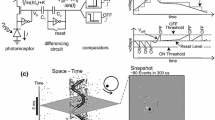Abstract
Implementing neuromorphic algorithms is increasingly interesting as the error resilience and low-area, low-energy nature of biological systems becomes the potential solution for problems in robotics and artificial intelligence. While conventional digital methods are inefficient in implementing massively parallel systems, analog solutions are hard to design and program. Stochastic Computing (SC) is a natural bridge that allows pseudo-analog computations in the digital domain using low complexity hardware. However, large scale SC systems traditionally suffered from long latencies, hence higher energy consumption. This work develops a VLSI architecture for an SC based binocular vision system based on a disparity-energy model that emulates the hierarchical multi-layered neural structure in the primary visual cortex. The 3-layer neural network architecture is biologically plausible and is tuned to detecting 5 different disparities. The architecture is compact, adder-free, and achieves better disparity detection compared to a floating-point version by using a modified disparity-energy model. A generalized 1x100 pixel processing system is synthesized using TSMC 65nm CMOS technology and it achieves 71 % reduction in area-delay product and 48 % in energy savings compared to a fixed-point implementation at equivalent precision.



























Similar content being viewed by others
References
Alaghi, A., & Hayes, J. P. (2013). Exploiting correlation in stochastic circuit design. In IEEE 31st International Conference on Computer Design (ICCD) (pp. 39–46): IEEE.
Alaghi, A., Li, C., & Hayes, J. P. (2013). Stochastic circuits for real-time image-processing applications. In Design Automation Conference.
Alfke, P. (1998). Efficient shift registers, LFSR counters, and long pseudo-random sequence generators. http://www.xilinx.com/bvdocs/appnotes/xapp052.pdf.
Anzai, A., Ohzawa, I., & Freeman, R. D. (1997). Neural mechanisms underlying binocular fusion and stereopsis: position vs. phase. Proceedings of the National Academy of Sciences, 94(10), 5438–5443.
Boga, K., Onizawa, N., Leduc-Primeau, F., Matsumiya, K., Hanyu, T., & Gross, W. J. (2015). Stochastic implementation of the disparity energy model for depth perception. In IEEE Workshop on Signal Processing Systems (SiPS) (pp. 1–6).
Brown, B. D., & Card, H. C. (2001). Stochastic neural computation. I. computational elements. IEEE Computer, 50(9), 891–905.
Chang, Y. -N., & Parhi, K. K. (2013). Architectures for digital filters using stochastic computing. In IEEE International Conference on Acoustics, Speech and Signal Processing (ICASSP) (pp. 2697–2701).
Chen, J., & Hu, J. (2013). A novel FIR filter based on stochastic logic. In Proceedings of IEEE International Symposium on Circuits and Systems (ISCAS) (pp. 2050–2053).
Choi, T. Y. W., Merolla, P. A., Arthur, J. V., Boahen, K. A., & Shi, B. E. (2005). Neuromorphic implementation of orientation hypercolumns. IEEE Transactions Circuits Systems I, Reg Papers, 52(6), 1049–1060.
Cumming, B. G., & Parker, A. J. (1997). Responses of primary visual cortical neurons to binocular disparity without depth perception. Nature, 389(6648), 280–283.
Janer, C. L., Quero, J. M., Ortega, J. G., & Franquelo, L. G. (1996). Fully parallel stochastic computation architecture. IEEE Signal Processing, 44(8), 2110–2117.
Leduc-Primeau, F., Gaudet, V. C., & Gross, W. J. (2015). Stochastic decoders for LDPC codes. In Advanced Hardware Design for Error Correcting Codes (pp. 105–128): Springer.
Li, P., Lilja, D. J., Qian, W., Bazargan, K., & Riedel, M. D. (2014). Computation on stochastic bit streams digital image processing case studies. IEEE Trans Very Large Scale Integration (VLSI) System, 22(3), 449–462.
Li, Y., & Hu, J. (2013). A novel implementation scheme for high area-efficient dct based on signed stochastic computation. In Proceedings of IEEE International Symposium on Circuits and Systems (ISCAS) (pp. 990?-993).
Liu, S. -C., Kramer, J., Indiveri, G., Delbruèck, T., Burg, T.s, & Douglas, R. (2001). Orientation-selective aVLSI spiking neurons. Neural Networks, 14(6), 629–643.
Ma, C., Zhong, S., & Dang, H. (2012). High fault tolerant image processing system based on stochastic computing.
McMahon, M. J., Packer, O. S., & Dacey, D. M. (2004). The classical receptive field surround of primate parasol ganglion cells is mediated primarily by a non-gabaergic pathway. The Journal of neuroscience, 24(15), 3736–3745.
Mutch, J., & Lowe, D. G. (2008). Object class recognition and localization using sparse features with limited receptive fields. International Journal of Computer Vision, 80(1), 45–57.
Ohzawa, I., Deangelis, G. C., & Freeman, R. D. (1990). Stereoscopic depth discrimination in the visual cortex: neurons ideally suited as disparity detectors. Science, 249(4972), 1037–1041.
Onizawa, N., Katagiri, D., Gross, W. J., & Hanyu, T. Analog-to-stochastic converter using magnetic tunnel junction devices for vision chips. In IEEE Transactions on Nanotechnology, 2016(to appear).
Onizawa, N., Katagiri, D., Matsumiya, K., Gross, W. J., & Hanyu, T. (2015). Gabor filter based on stochastic computation. IEEE Signal Process Letter, 22(9), 1224–1228.
Qian, N. (1997). Binocular disparity and the perception of depth. Neuron, 18(3), 359–368.
Shimonomura, K., Kushima, T., & Yagi, T. (2008). Binocular robot vision emulating disparity computation in the primary visual cortex. Neural Networks, 21(2), 331–340.
Tehrani, S. S., Naderi, A., Kamendje, G. -A., Hemati, S., Mannor, S., & Gross, W. J. (2010). Majority-based tracking forecast memories for stochastic LDPC decoding. IEEE Transactions Signal Processing, 58 (9).
Wang, R., Han, J., Cockburn, B., & Elliott, D. (2015). Design and evaluation of stochastic FIR filters. In IEEE Pacific Rim Conf. on Communications, Computers and Signal Processing (PACRIM) (pp. 407–412).
Acknowledgments
The authors would like to thank Hasan Mozafari, Arash Ardakani and Xinchi Chen for useful discussions. Warren J. Gross is a member of ReSMiQ (Regroupement Stratégique en Microsystémes du Québec) and SYTACom (Centre de recherche sur les systèmes et les technologies avancés en communications). This work was supported by the Brainware LSI Project of MEXT (Ministry of education, culture, sports, science and technology), Japan.
Author information
Authors and Affiliations
Corresponding author
Rights and permissions
About this article
Cite this article
Boga, K., Leduc-Primeau, F., Onizawa, N. et al. A Generalized Stochastic Implementation of the Disparity Energy Model for Depth Perception. J Sign Process Syst 90, 709–725 (2018). https://doi.org/10.1007/s11265-016-1197-3
Received:
Revised:
Accepted:
Published:
Issue Date:
DOI: https://doi.org/10.1007/s11265-016-1197-3




